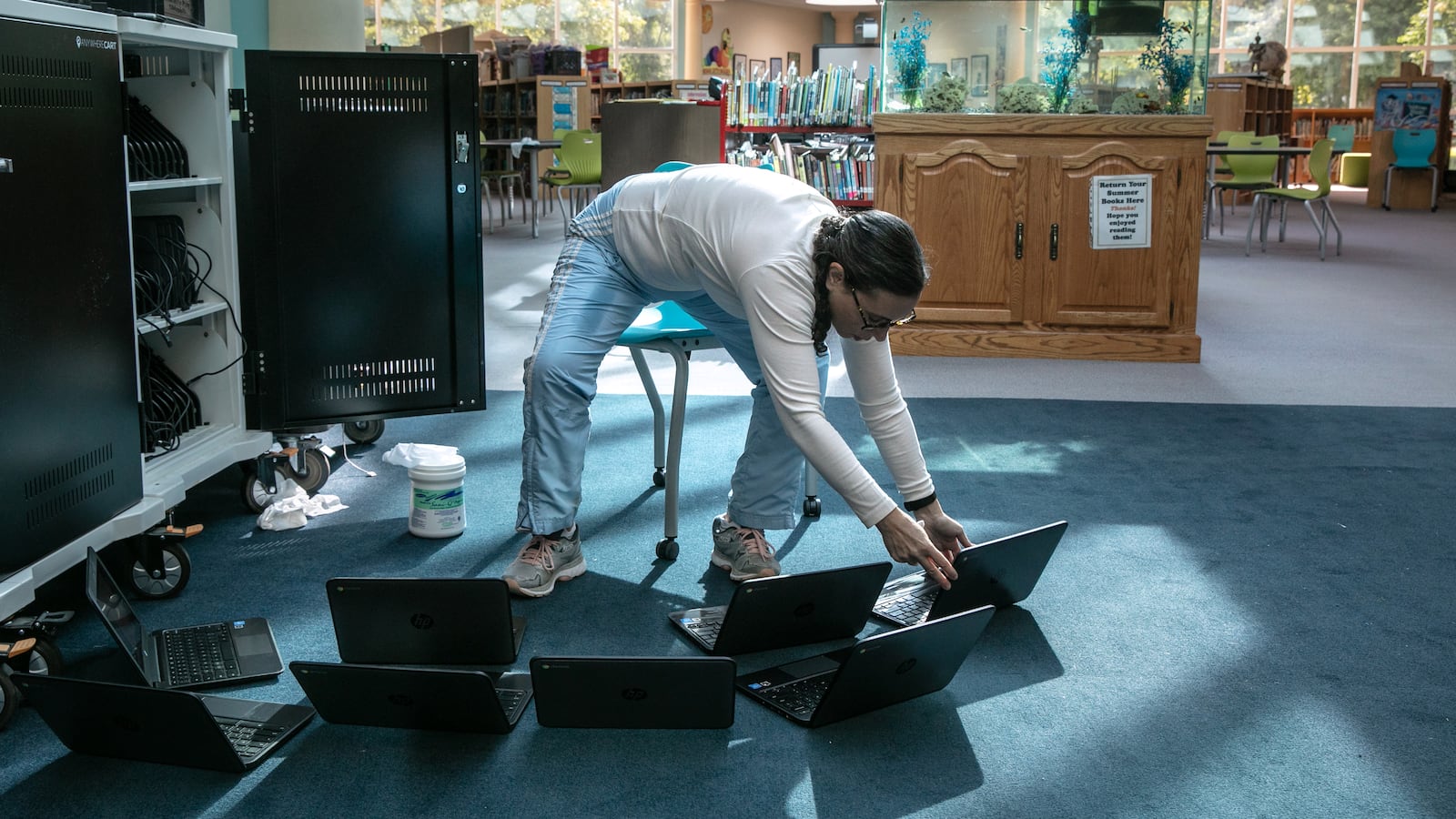As the back-to-school season unfolded in New York, the city’s teachers set up their classrooms how they usually do: by putting up posters, reading through curriculums, sharpening pencils, and, for roughly a decade, charging Chromebooks.
These lightweight laptops have become a staple of the post-COVID classroom, and for good reason. They allow students to learn at their own pace, access materials, and create projects and presentations without expensive items. Some superintendents across the city even require dedicated time for math and reading practice on computers.
As a member of Gen Z and a Brooklyn-based teacher, though, I worry that relying on technology for instruction will only exacerbate the negative effects of excess screen time.

I got my first iPhone on my 11th birthday. It was the beginning of sixth grade, braces, and the descent into the digital world. In these preteen years, I never understood why my parents questioned how much time I spent on my phone. I was just texting my friends, sending memes, sharing homework answers, and opening up about school crushes.
To me, it was the same as talking in person at each other’s houses, just without the hassle of deciding whose parent would drive us there. My parents, however, saw my phone use as a way of isolating myself from the family even when we were in the same room. The phone had become an adolescent addiction — and not just for me.
Recent research has shown how screen time, specifically time on smartphones, molds our brains well into adolescence and adulthood. In his widely discussed 2024 book “The Anxious Generation,” social psychologist Jonathan Haidt details how the cultural shift from a “play-based childhood” to a “phone-based childhood” corresponds to the spike in adolescent mental illness. Haidt cites data showing that since 2010, there has been a 139% increase in anxiety among 18- to 25-year-olds and a 145% and 161% increase in depression among teenage girls and boys, respectively.
Unfortunately, these numbers are not shocking. They mirror my experience and that of my friends as we rotated through antidepressants, sat in bed doom-scrolling, and resented peers with more likes and followers. We reminisced about our pre-iPhone days when we used to explore the neighborhood and were left to our own devices (no devices!) to navigate social, emotional, and physical challenges without adult intervention — a concept Haidt describes as “free play.”
The one place where I was free from the pressure to snap and scroll was school. I fell in love with English and U.S History and was embarrassingly eager to participate in class debates and discussions. These classes were opportunities for connection.
As the Chromecarts rolled in around eighth or ninth grade, however, the connection waned. Many STEM classes were tech-heavy, with pre-existing modules for students to follow independently with little interaction with peers and teachers. Remote learning at the height of the COVID-19 pandemic only made things worse.
When I started teaching middle school in Brooklyn last year, I realized that my students experienced this tech onslaught so much earlier than I did. I wondered how they managed to complete third and fourth grade virtually. How did they build foundational reading, math, social, emotional, and executive functioning skills while sitting behind a computer, tablet, or phone? How did they grow without the much-needed free play?
The reality is that many of them didn’t.
We need more Gen Z educators to be honest about their own relationship with technology.
Several of my students in this age group entered middle school with the same background knowledge they had before the year and a half of digital learning. In a U.S. history lesson, for example, my seventh graders were doing a round-robin reading of a passage about the Compromise of 1850. As different groups were reading, I was met with confusion over the pronunciation of the words “Kansas” and “Missouri.” It did not appear to be the typical mistakes that stem from skipping over words or mixing up letters, it was as if they had never seen the names of these states before. The same looks appeared when I asked what nouns and verbs are, or to count in groups of seven or eight. Didn’t you learn this in like, third grade, I thought to myself. Then I remembered what happened when they were in third grade.
Fortunately, this cohort of students has made tremendous academic and social-emotional strides since moving back into the physical classroom. As they’ve returned, though, they’ve brought with them habits that reinforce the need for instant gratification.
With a Chromebook by their side all day, they will often Google answers to any and all questions, including those that ask for their thoughts and analyses. These days, it’s common to forgo memorizing your friends’ phone numbers and street addresses and, by the same logic, times tables and rudimentary spelling. Why memorize the product of 6 and 8, or the difference between “there” and “their,” or learn to read an analog clock when you can just look it up? And how can we expect our students to learn these foundational pieces of background knowledge without giving them an opportunity to struggle through the challenge of learning?
When schoolwork and peers get boring or frustrating, they can fill their time (or avoid difficult conversations) by scrolling through Pinterest, Google Images, or surreptitiously perusing Snapchat. I don’t blame them — I’ve also developed the habit of filling unoccupied and stressful moments with aimless scrolling. But when we lose boredom, we lose space for creativity and reflection; when we escape our problems, we cannot learn to problem-solve.
As I plan for this school year, I meticulously walk the fine digital line: I want to encourage independent and flexible work habits, which can be done with online assignments. Yet, I also want to encourage interdependent thinking and discussion skills, which are harder to achieve on a screen.
I believe teaching digital literacy and screen hygiene is the most responsible approach to the issue, but to be effective, we need more Gen Z educators to be honest about their own relationship with technology. We didn’t know of its detrimental impacts or addictive nature back in the days of Kik and Omegle., c. 2013. Now that we do, we can equip our students with the tools to avoid this adolescent addiction.
Skyler Graham is a co-teacher apprentice at Ember Charter Schools. She currently teaches high school English and social studies. More of her work can be found here.


